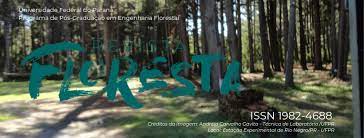Ver ítem
- xmlui.general.dspace_homeCentros Regionales y EEAsCentro Regional MisionesEEA MontecarloArtículos científicosxmlui.ArtifactBrowser.ItemViewer.trail
- Inicio
- Centros Regionales y EEAs
- Centro Regional Misiones
- EEA Montecarlo
- Artículos científicos
- Ver ítem
Efeitos da exploração convencional e de impacto reduzido em uma floresta estacional semidecidual na Provincia de Misiones, Nordeste da Argentina
Resumen
O presente estudo foi desenvolvido na Reserva Florestal de Uso Múltiplo Guarani, na província de Misiones, Argentina. Foram instaladas 15 parcelas permanentes, de quatro hectares cada, com uma área efetiva de medição de um hectare, distribuídas em três tratamentos: Exploração Convencional (EC), Exploração de Impacto Reduzido (EIR) e Testemunha. Foram considerados todos os indivíduos arbóreos com diâmetro à altura do peito (DAP) ³10 cm um ano antes da
[ver mas...]
O presente estudo foi desenvolvido na Reserva Florestal de Uso Múltiplo Guarani, na província de Misiones, Argentina. Foram instaladas 15 parcelas permanentes, de quatro hectares cada, com uma área efetiva de medição de um hectare, distribuídas em três tratamentos: Exploração Convencional (EC), Exploração de Impacto Reduzido (EIR) e Testemunha. Foram considerados todos os indivíduos arbóreos com diâmetro à altura do peito (DAP) ³10 cm um ano antes da exploração, em 1998, e oito anos depois, em 2006. A exploração criou uma superfície total de clareiras de 8.018,7 m2, representando 6,7% da área total amostrada, 65% gerados pela EC. A área basal danificada foi superior na EC (70% do total). A EIR concentrou as clareiras em classes de tamanhos inferiores, com áreas médias menores. O número de indivíduos danificados foi de 13,6 ind.ha-1, com uma percentagem superior de danos ocasionada pela EC. O abate do indivíduo foi a principal causa do dano, e a parte da árvore mais danificada, a copa. Determinou-se uma relação positiva e significativa entre a área basal explorada e a área basal danificada (R2 = 0,49). O planejamento da exploração é o fator principal na redução dos danos aos indivíduos remanescentes, sendo o abate direcionando a queda da árvore uma das técnicas que minimiza os danos.
[Cerrar]
The present study was developed in the Multiple Use Guarani Forest Reserve, in Misiones, Argentine. There, 15 permanent plots of four hectare each one were installed. Each plot had an effective area of one hectare measured and it was distributed in three treatments: Conventional Logging, Reduced Impact Logging and control. At the year of logging (1999) and eight years later (2006), all the trees larger than 10 cm of
[ver mas...]
The present study was developed in the Multiple Use Guarani Forest Reserve, in Misiones, Argentine. There, 15 permanent plots of four hectare each one were installed. Each plot had an effective area of one hectare measured and it was distributed in three treatments: Conventional Logging, Reduced Impact Logging and control. At the year of logging (1999) and eight years later (2006), all the trees larger than 10 cm of diameter at breast height (DBH) were measured. The logging created a total surface of gaps of 8,018.7 m2, which represented 6.7% of the total sampled area, where 65% were generated by the Conventional Logging. The basal area damaged was higher in the Conventional Logging treatment (70% of the total). The Reduced Impact Logging concentrates the gaps on classes of lower sizes and in smaller average areas. The number of damaged individuals was 13.6 stems.ha-1, with a higher percentage of damages caused by the Conventional Logging. The cut of individuals was the main cause of damage and the crown was the most damaged part of the tree. A positive and significant relation was determined between the logging basal area and the damaged basal area (R2 = 0.49). The planning of the logging showed to be the main factor in the reduction of the hold over stem damages. Beyond that, the slaughter directing the tree fall showed to be one of the techniques that reduce damages.
[Cerrar]

Autor
Bulfe, Nardia María;
Galvão, Franklin;
Figueiredo Filho, Afonso;
Mac Donagh, Patrício;
Fuente
Revista Floresta 39 (2) : 365-379. (abr.-jun. 2009)
Fecha
2009
Editorial
Centro de Pesquisas Florestais da Faculdade de Florestas da Universidade Federal do Paraná
ISSN
0015-3826
1982-4688
1982-4688
Formato
pdf
Tipo de documento
artículo
Palabras Claves
Derechos de acceso
Abierto
 Excepto donde se diga explicitamente, este item se publica bajo la siguiente descripción: Creative Commons Attribution-NonCommercial-ShareAlike 2.5 Unported (CC BY-NC-SA 2.5)
Excepto donde se diga explicitamente, este item se publica bajo la siguiente descripción: Creative Commons Attribution-NonCommercial-ShareAlike 2.5 Unported (CC BY-NC-SA 2.5)


